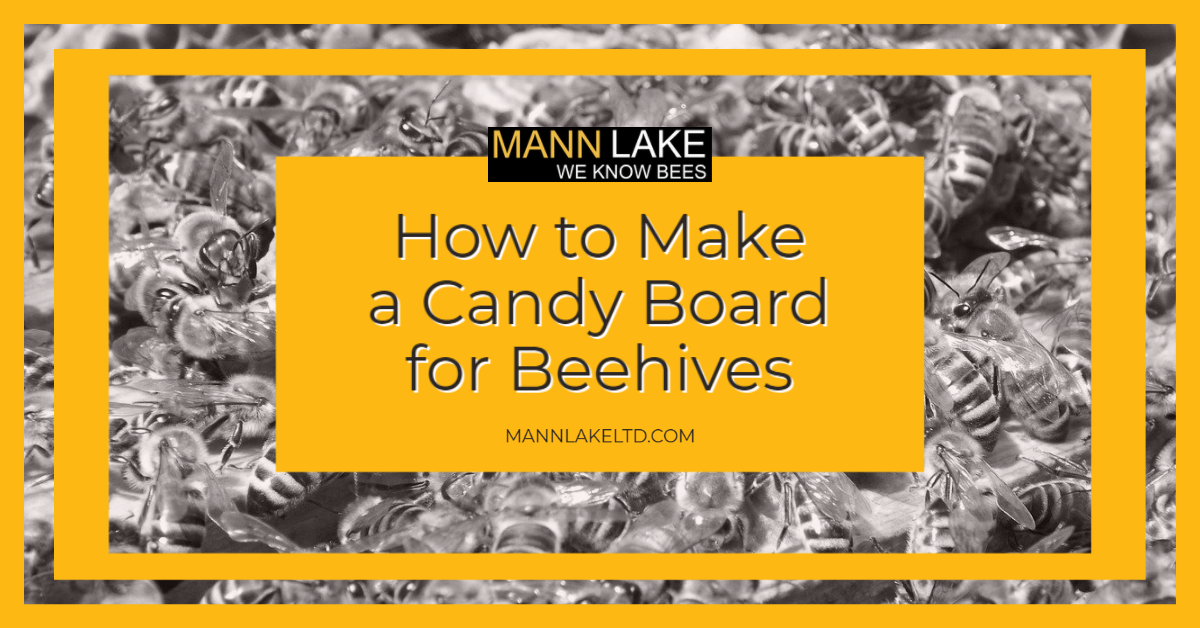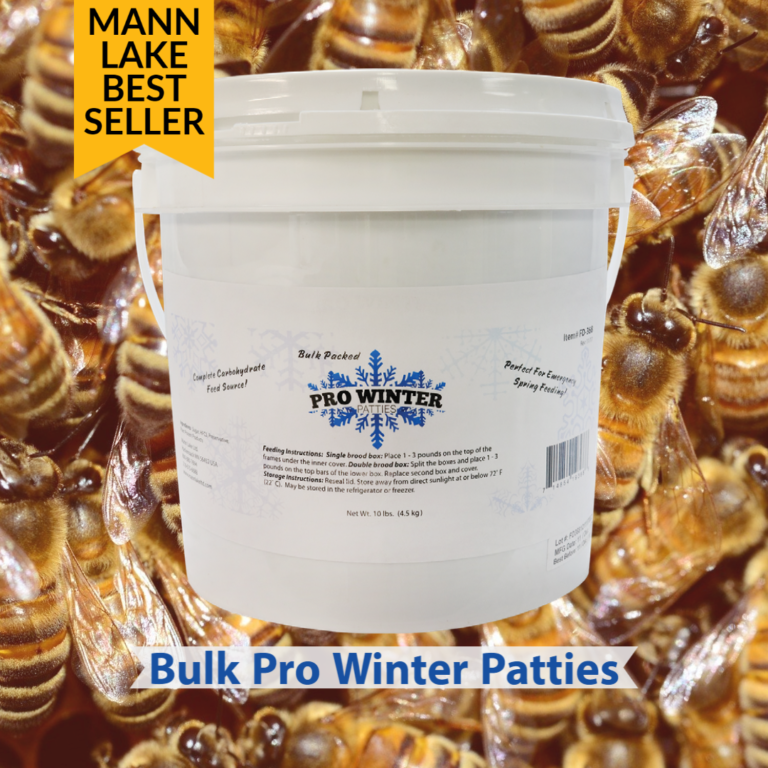How To Make Candy Board For Beehives
Like many creatures, honey bees spend the year building up their food stores for the winter. When the cold weather hits, your colony will rely on its supply of honey to survive throughout the season. Honey bees spend the winter huddled up in a cluster around the queen. The worker bees’ body heat keeps the entire cluster—and the hive—warm and toasty. However, this process takes energy, which means the bees must have a reliable food source within the hive.
If honey supplies are low, you can place winter patties or a candy board inside the hive. This board with sugar candy is one of the most valuable sources of sustenance for your bees during the winter. There are no-cook and cooked recipes for making these sugar boards for bees.
Learn why winter feeds are important and how to make a candy board for beehives with this guide.

Why You Need Winter Feed Your Honey Bees
As your honey bees cluster up for the winter, you want to ensure they have plenty of food all season long. A strong colony should make enough honey to last throughout the winter, but there are many reasons your honey bees might need a little help.
Longer winters, harder summers, and other complications might lead to your honey bees going through their honey a little too quickly. That’s where winter feeds such as Bulk Pro Winter Patties or candy boards come in. Placing feed within the hive gives you peace of mind—the extra sugar will sustain them until spring when your worker bees can get out and start foraging again.
Winter Feed Patties
Winter feed patties are the most beneficial option for feeding your bees during the winter months as they contain carbohydrates and other nutrients. Plus, feed patties are convenient and easy to distribute to your hive. Make sure to use a “winter blend” patty because it doesn’t contain as high a level of protein as a traditional pollen patty. In the middle of winter, extra protein may encourage brood production and a population boom that will further dwindle your hive’s food stores.
Candy Boards
Candy boards provide two main great benefits:
- Feeding: This additional sustenance helps bees survive winter and stave off starvation.
- Moisture control: The board can act as a moisture absorber, as too much winter moisture can harm bees. A moisture board can also help control condensation buildup in the hive and keep bees dry in the winter. This board is placed on top of the inner cover, whose design includes ventilation.
Once you place the candy board on the hive, the task is done. You can check and replace the board as needed.
Candy Board Recipes
You can find endless recipes for how to make a candy board for beehives online, but most fall into two categories: cooked and no-cook recipes.
What You Need for Your Candy Boards
Gather all your materials to make candy boards:
- Candy board frame
- Insulated inner cover
- Parchment paper or packing paper
- Ingredients for the sugar candy mixture
- Tub or container for mixing the ingredients
- Pot or pan
- Spatula or spoon
Do You Need to Make a Candy Board Frame?
You can actually buy a candy board frame, like this wintering inner cover that doubles as a candy board mold.
If you opt to build your candy board frame, remember these points:
- Make sure the frame matches the dimensions of your hive boxes.
- The frame can be as high as 2 to 3 inches to hold sugar candy adequate to feed your bees.
- Drill a front hole for ventilation and access.
Whether DIY or store-bought, the construction and configuration of the candy board frame can vary. What matters is that the frame can hold the food well.
You can also use a candy board feeder, which looks like a shallow super box with a bottom part (for packing in the candy) and functions similarly.
Cooked Candy Board Recipes
Cooked candy recipes work the same as any simple hard candy recipe. Here are the main steps:
- Bring a pot of water to a boil, and then stir in your granulated sugar.
- Continue to stir and heat the mixture until it reads 240°F on a candy monitor.
- Remove the pot from heat, and allow the mixture to cool slightly to around 195°F.
- Next, pour your mixture into your candy board frame.
- You can use the interior of your inner cover or make your own candy board to fit inside the hive.
- For added sustenance, you can add pieces of pollen patties throughout the board. (This bee pollen substitute with essential vitamins, antioxidants, and trace minerals can be mixed into sugar syrup to make those pollen patties.)
- Once the candy has hardened, install the board in the hive and let your honey bees enjoy their treats.
Uncooked Candy Board Recipes
No-cook candy boards offer an even simpler solution to feed your honey bees.
Instead of boiling your water, mix it slowly with your sugar to create a sand-like substance. You can also add vinegar to your water before mixing it in. This will prevent mold from forming once you install the sugar board in the hive. Adding vinegar as a mold inhibitor is optional.
Getting the balance of the mixture right might take some experimentation. You want your sugar to be moist and cakey, but not runny.
Once the mix is ready, spread it across your candy board. Unlike hard candy, this mixture won’t do well hanging at the top of your hive. You’ll want to buy a candy board that supports the feed and contains entrances for your honey bees to reach the candy. You can line it with parchment paper—cut a hole in the paper for bees to easily access the candy. You can also add extra nutrients by placing bits of pollen patties throughout the candy board.
Sugar Bricks for Bee Feeding
You may have heard of sugar bricks as a supplemental feed for bees. The concoction also involves mixing water with sugar. You can mix the ingredients in a pail or bucket using a mixer, drill, or spoon. Some recipes use vinegar.
You’ll also need molds or pans to pack in the mixture or bricks when they harden, which then go to a feeding shim. The shim must be installed in the hive beforehand.
This no-cook sugar brick recipe is one of the most famous out there.
What about Pollen Patties?
Pollen is an important source of protein, vitamins, and minerals for honey bees. Protein from pollen is essential for hive growth.
Worker bees collect pollen from plants during the foraging season. Bees may have to be fed with pollen patties to get their protein boost, plus carbohydrates and fats.
While named pollen patties, they don’t contain pollen. They are used to simulate protein needed in brood rearing.
Here’s one recipe to make a pollen patty:
- Dissolve 1/2 cup of granulated sugar in half a cup of hot water.
- Mix in a cup of pollen powder or substitute, and aim for a firm consistency. Then add a drop or two of a supplement (e.g., HoneyBee Healthy).
- Pour the mixture on wax paper and fold the paper over it. Refrigerate and thaw when you need to take it to the hive for feeding.
- Place the pollen patty under the board, atop the frames, and at the center for easy access to bees.
But do you need to feed pollen patties to bees during winter? The traditional patties, rich in protein, spur colony growth, which, in turn, dwindles the food stores. That’s why winter-blend or winter patties exist. They are low-protein winter patties formulated to help bees survive winter.
Winter Feeding FAQs for Beekeepers
Why do you make candy boards?
They make practical emergency or supplemental winter feeding; some call them insurance. The sugar boards are not meant to replace honey but to act as a food source for bees to ensure they have an adequate supply or in case their stores get depleted in an unpredictable winter.
When is the best time to add a candy board to the hive?
The perfect time for installing candy boards depends on where your hive boxes are located and the level of honey stores.
You can refer to this guide to honey bee management practices throughout the seasons, noting that brood rearing commences in winter and peaks in spring. The same guide notes nurse bees feeding themselves and the brood with stored honey and pollen in late winter and early spring.
Given the bee colony activities in winter and your hive’s unique circumstances, putting the candy boards during fall or winter, the first week of December (or December 22 this year) may be ideal.
Where do you place the candy board?
The board is placed on top of the hive. It often takes the place of the inner cover, but in some cases, you can set the inner cover atop the candy board.
Watch our video to help you winterize your hives and prepare them for winter.
Whether you use winter patties, candy boards, or similar feed for your honey bees, you’ll be giving them a reliable food source to help get them through the colder months.


